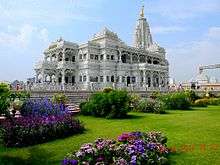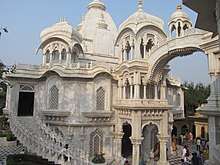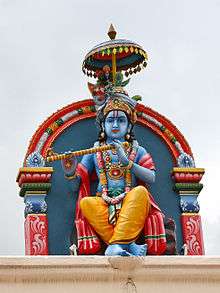Vrindavan
Vrindavan (![]()
Vrindavan Brindaban | |
|---|---|
   Top to bottom: Krishna Balaram Mandir, Kusum Sarovar, and Prem Mandir (Love temple) in Vrindavan | |
| Nicknames: City of Widows | |
 Vrindavan Location in Uttar Pradesh, India  Vrindavan Vrindavan (India) | |
| Coordinates: 27.58°N 77.7°E | |
| Country | |
| State | Uttar Pradesh |
| District | Mathura |
| Government | |
| • Type | Municipal Council |
| • Body | Vrindavan Municipal Council |
| Elevation | 170 m (560 ft) |
| Population (2011)[1] | |
| • Total | 63,005 |
| Demonym(s) | Vrindavan wasi |
| Languages | |
| • Official | Hindi |
| • Native | Braj Bhasha dialect |
| Time zone | UTC+05:30 (IST) |
| PIN | 281121 |
| Telephone code | 0565 |
| Vehicle registration | UP-85 |
Etymology
The ancient Sanskrit name of the city, Vṛndāvana, comes from its groves of vṛndā (Holy basil) and vana (a grove or forest).[2]
Geography
Vrindavan is located at 27.58°N 77.7°E.[7] It has an average elevation of 170 metres (557 feet).
Demographics
As of 2011 Indian Census, Vrindavan had a total population of 63,005, of which 34,769 were males and 28,236 were females. Population within the age group of 0 to 6 years was 7,818. The total number of literates in Vrindavan was 42,917, which constituted 68.11% of the population with male literacy of 73.7% and female literacy of 61.2%. The effective literacy rate of 7+ population of Vrindavan was 77.8%, of which male literacy rate was 83.7% and female literacy rate was 70.3%. The sex ratio is 812 females per 1000 males. The Scheduled Castes and Scheduled Tribes population was 6,294 and 18, respectively. Vrindavan had 11,637 households in 2011.[1][8]
Religious heritage
.jpg)
Vrindavan is considered to be a holy place for Vaisnavism tradition of Hinduism. It is a center of Krishna worship and the area includes places like Govardhana and Gokul that are associated with Krishna. Millions of devotees of Radha Krishna visit these places of pilgrimage every year and participate in a number of festivals.[9]
History

Vrindavan has an ancient past, associated with Hindu culture and history, and was established in the 16th and 17th centuries as a result of an explicit treaty between Muslims and Hindu Emperors,[10] and is an important Hindu pilgrimage site since long.
Of the contemporary times, Vallabhacharya, aged eleven visited Vrindavan. Later on, he performed three pilgrimages of India, barefoot giving discourses on Bhagavad Gita at 84 places. These 84 places are known as Chaurāsi Baithak and since then are the places of pilgrimage. Yet, he stayed in Vrindavan for four months each year. Vrindavan thus heavily influenced his formation of Pushtimarg.
The essence of Vrindavan was lost over time until the 16th century, when it was rediscovered by Chaitanya Mahaprabhu. In the year 1515, Chaitanya Mahaprabhu visited Vrindavana, with the purpose of locating the lost holy places associated with Krishna's life.[11]
In the last 250 years, the extensive forests of Vrindavan have been subjected to urbanisation, first by local Rajas and in recent decades by apartment developers. The forest cover has been whittled away to only a few remaining spots, and the local wildlife, including peacocks, cows, monkeys and a variety of bird species has been virtually eliminated. Only a few peacocks are left in the city but monkeys and cows can be seen almost everywhere.
Temples

Vrindavan, the land of Radha Rani, the City of Temples has more than 1000 temples to showcase the pastimes of Radha and Krishna.[12] Some of the important pilgrim sites are
- Madan Mohan Temple, located near the Kalidah Ghat was built by Kapur Ram Das of Multan. One of the oldest temples in Vrindavan, it is closely associated with the Lord Chaitanya Mahaprabhu. The original deity of Lord Madan Gopal was shifted from the shrine to Karauli in Rajasthan for safekeeping during Aurangzeb's rule. Today, a replica of the original (deity) is worshipped at the temple
- Govind Dev Temple (Sri Radha Govinda Temple) was a seven storeyed structure built by Raja Man Singh with red sandstone donated by Akbar in 1590.[13] It was destroyed by Mughal ruler Aurangzeb.[14].
- New Radha Govinda Temple was built by Sri Krishna Balaram Swamiji and was completed in 2004 is based on a historic temple built about 500 years ago by Srila Rupa Goswami, a direct Sanyasi disciple of Sri Chaitanya Mahaprabhu.[15]
- Sri Radha Raman Mandir, constructed at the request of Gopala Bhatta Goswami and houses a saligram deity of Krishna as Radha Ramana, alongside Radha.[16]
- Radha Damodar Mandir, located at Seva Kunj was established in 1542 by Six Gosvamis of Vrindavan. The main deities are Radha–Damodar.
- Radha Vallabh Temple, set up by Hith Harivansh Mahaprabhu has a crown of Radharani placed next to the Krishna in the sanctum.[17]
- Sri Rupa Sanatana Gaudiya Matha, located near Seva Kunja, was founded by Srila Bhaktivedanta Narayana Gosvami Maharaja.[18]
- Shahji Temple, designed and built in 1876 by Shah Kundan Lal of Lucknow. Noted for its magnificent architecture and beautiful marble sculptures, the temple has twelve spiral columns each 15 feet high and a hall with Belgian glass chandeliers and paintings.
- Meera Bai Temple, located at the southern side of Shahji temple near Nidhivan and is dedicated to Meera. Some hagiography state she miraculously disappeared by merging into a deity of Krishna at Dwarika in 1547.[19] While miracles are contested by scholars for the lack of historical evidence, it is widely acknowledged that Meera dedicated her life to Hindu deity Krishna, composing songs of devotion and was one of the most important poet-Sant of the Bhakti movement period.[20][21]
- Banke Bihari Temple, built in 1862[22] after the image of Banke-Bihari was discovered in Nidhi Vana by Swami Haridas.
- Prem Mandir is a spiritual complex situated on a 54-acre site on the outskirts of Vrindavan dedicated to divine love. The temple structure was established by spiritual guru Kripalu Maharaj.[23] The main structure built in marble and figures of Krishna cover the main temple.[24]

- Sri Krishna-Balarama Temple was built by the International Society for Krishna Consciousness (ISKCON) in Raman-Reti.[25] The principal deities of this temple are Krishna and Balaram, with Radha–Shyamasundar and Gaura-Nitai alongside. Adjoining the temple is the samadhi of A. C. Bhaktivedanta Swami Prabhupada, the founder of ISKCON, built in pure white marble.
- Sri Rangji Temple, built in 1851 is dedicated to Lord Sri Goda-Rangamannar, where Sri Ranganath (a form of Vishnu, resting on the coils of the sacred Sesha Naga) is present as a beautiful bridegroom(RangaMannar) along with Sri Goda devi (Andaal in Tamil). The temple built in the Dravidian style has a gopuram of six storeys and a gold-plated Dhwaja stambha, 50 feet high. The temple follows the SriVaishanvism school of philosophy propagated by Sri Ramanujacharya (11th century scholar and saint). The temple is a Divyadesha and has several important festivals celebrated all throughout the year, chief among them is 'SriBrahmotsava' which is a 10 day festival which usually falls in March–April and is marked by the pulling of the Temple car by the devotees from the temple to the adjoining gardens.
- Sneh Bihari Mandir, Vrindavan - This temple located in the heart of Vrindavan is based on Haridasiya Sampradhay. About 250 years ago there existed a small temple established by Shri Snehi Lal Goswami, the 10th generation Goswami of Swami Shri Haridas. This complex was well expanded and renovated in 2003 by Bhagwat Mission under the leadership Guru Ji Goswami Shri Mridul Krishna ji Maharaj. Built across 1000 square yards, it is the result of the dedication of over 1500 workers. Made up of exclusive white and red marble, it is elegantly designed with traditional carvings. There are over 80 beautifully designed columns that give the temple a touch of royalty.[26]
- Jaipur Temple, built by Sawai Madho Singh II, the Maharaja of Jaipur in 1917 dedicated to Radha–Madhava.[27]
- Pagal Baba Temple, Liladham, Vrindavan - Temple is beautifully designed with white marble stone. There are seven temples, one on top of another. All temples have beautiful deities. Presently this is the tallest temple in Vrindavan. The temple is famous for its puppet exhibition. Liland Thakur was a Justice in the High court of Calcutta, and after resigning from the post he came to Vrindavan in search of truth and Lord Krishna. He was wandering here like a madman so people were calling him Pagal Baba only to later realise his powers.[28]
- Neeb (Neem) Karori Baba Samadhi Temple, Gaushala Nagar - Maharajji's beautiful Vrindavan ashram is the likely the most propitious of the ashrams and temples of Maharajji Neem Karoli Baba who is renowned world over with ashrams and temples built in over one hundred places in his name. The first temple was inaugurated in 1967. It was in Vrindaban that Maharajji chose to leave His body in 1973. The temple at the cremation place of Maharajji's last known body is called Samadhi Sthal. This is the site of Maharaj Ji's Mahasamadhi Bhandara in September each year.[29]
- Vrinda Kunja, Goda Vihar - this 200-year-old ashram and temple originally built by the queen of Manipur, renovated in 1989 by Paramadvaiti Swamiji is now a majestic building.[30]
- Mandir Sri Dham Goda Vihar, Goda Vihar is located close to Vrinda kunja.[31]
- Jagannatha Mandir, Goda Vihar, Vrindavana - Shri Haridas Ji Maharaj, a Vaishnav saint of Vrindavan brought idols of Shri Jagannath Ji, Shri Balram ji and Subhadra Devi from Puri Jagannath Mandir and installed here. The temple is one of the most famous and old temples of Vrindavan, built about five centuries ago.[32]
.jpg)
- Maa Katyayani Mandir is situated in Radha Bagh, near Rangnath mandir. This is one of suddh Shakti Peetha of Shakti, established in 1923 by a Kriya Yogi, Sri Yogiraj Swami Keshavananda Brahmachari.
- Tekari Rani Temple, Goda Vihar - located close to Tekri Rani Ghat on the banks of River Yamuna along Mathura road, this vast Tekari Rani Temple built in Rajasthani architecture is one of the finest monuments in Vrindavan. About two hundred years ago the queen of Tekri while visiting Vrindavan was hounded by dacoits. Queen with her beloved deity of Lord Gopal managed to escape from them safely. Later on a temple complex was built here in. There is also a small palace built in this place.[33]
- Bhuteshwar Mahadev Temple, a shrine believed to be a Shakti Peetha where ringlets of hair of Sati Devi is believed to have fallen.[34][35]
- Garud Govind Temple is located on the turn of NH-2 to Vrindavan in Chhatikara village.[36]
- Chintaharan Hanuman Mandir, temple of Lord Hanuman is situated near Atalvan
- Radha Ras Bihari Ashta Sakhi Temple, dedicated to the divine couple Radha-Krishna and their Ashta Sakhis (eight companions).
- Maa Vaishno Devi Dham, Chhatikara - this recently constructed Maa Vaishno Devi Dham near Vrindavan hosts an array of statues, articles, and abodes which are awe-inspiring. Maa Vaishno's Murti is the star attraction of the Dham. This statue is a colossal neoclassical sculpture measuring 141 ft tall from the ground level and weighing 1700 ton.[37]
- Priyakantju Mandir, Allhepur - Vishwa Shanti Sewa Charitable Trust built this temple in 2009. This unique lotus shaped temple complex spreading over a land of 2.5 acres was built at around the cost of about 40 crores.[38]
- Vrindavan Chandrodaya Mandir is housed in a modern geodesic structure with a traditional gopuram based on khajuraho style of architecture. It is being built by one of the ISKCON factions based in Bangalore.[39] At cost of ₹300 crore (US$42 million) it will be the tallest temple in world on completion.
- Bhajan kutir Ashram was established by Golokbasi 1008 Bhagawat Sharan Maharaj Ji who was originally from Nepal. This ashram has been a long lasting symbol of Nepal and India Friendship at peoples level. Several thousands of Nepalese devotees, students, saints has been part of this almost 150 yrs old ashrams and contributed for the Shri Vrindavandham's diverse heritage.[40]
City of Widows
Vrindavan is also known as the "city of widows"[41] due to the large number of widows who move into the town and surrounding area after losing their husbands. There are an estimated 15,000 to 20,000 widows. The widows come from states of west Bengal, Assam and Odisha.[42][43] Many spend time singing bhajan hymns at bhajanashrams. An organisation called Guild of Service was formed to assist these deprived women and children.[41][43] According to a survey report prepared by the government, several homes run by the government and different NGOs for widows.[44]
Transportation
Road
Vrindavan is well connected by roads and is connected to Delhi by National Highway (NH) 44 of the Golden Quadrilateral network. Earlier it was NH 2. [5]
Rail
- BDB/Vrindavan is on the Mathura-Vrindavan MG link.
- VRBD/Vrindaban Road is on the Agra-Delhi chord.
See also
- Radha-vallabha
- Govardhana sila
- Gokul
References
- "Census of India: Vrindavan". www.censusindia.gov.in. Retrieved 9 October 2019.
- "Brindaban". The Imperial Gazetteer of India. 1909.
- Gopal, Madan (1990). K.S. Gautam (ed.). India through the ages. Publication Division, Ministry of Information and Broadcasting, Government of India. p. 176.
- "UP gets first officially designated 'teerth sthals' in Vrindavan and Barsana". Times of India. 27 October 2017.
- "NHAI". Retrieved 14 February 2018.
- Keene, Henry George (1899). "Bindrabun". A Handbook for Visitors to Agra and Its Neighbourhood. Thacker, Spink & Co. pp. 98–106.
- "Maps, Weather, and Airports for Vrindavan, India". www.fallingrain.com. Retrieved 6 December 2019.
- Jayant Pandurang Nayaka, Syed Nurullah (1974). A students' history of education in India (1800–1973) (6 ed.). Macmillan.CS1 maint: uses authors parameter (link)
- Klaus Klostermaier (2007). A Survey of Hinduism. State University of New York Press; 3 edition. p. 204. ISBN 978-0-7914-7081-7.
The center of Krishna-worship has been for a long time Brajbhumi, the district of Mathura that embraces also Vrindavana, Govardhana, and Gokula, associated with Krishna from the time immemorial. Many millions of Krishna bhaktas visit these places every year and participate in the numerous festivals that re-enact divine scenes from Krishna's life on Earth, of which were spent in those very places
Vrinda means Tulsi (A sacred species of flora) and van as forest, therefore Vrindavan is a holy forest of Tulsi. Vijaypal Baghel, known as GreenMan is promoting, planting and farming Tulsi in mass around the Vrindavan. - "Watch | John Stratton Hawley on His Latest Book on 'Krishna's Playground'". The Wire. 25 January 2020. Retrieved 3 March 2020.
- "Discovery of Vrindavan by Chaitanya Mahaprabhu". Retrieved 6 December 2019.
- http://news.vrindavantoday.org/2016/06/seven-main-temples-of-vrindavan
- Chisholm, Hugh, ed. (1911). . Encyclopædia Britannica. 4 (11th ed.). Cambridge University Press. p. 571.
- http://uptourism.gov.in/pages/top/explore/top-explore-mathura---vrindavan/govind-dev-temple
- "Red Stone Temple". Retrieved 6 December 2019.
- "Sri Radha Raman in Vrindavan". www.salagram.net. Retrieved 6 December 2019.
- Vision, Kavita. "Radha Krishna Spiritual Portal". www.radhavallabh.com. Retrieved 6 December 2019.
- "Sri Rupa Sanatana Gaudiya Math - Vrindvana, India". www.purebhakti.com. Retrieved 6 December 2019.
- Usha Nilsson (1997), Mira Bai, Sahitya Akademi, ISBN 978-8126004119, pages 1-15
- Usha Nilsson (1997), Mira bai, Sahitya Akademi, ISBN 978-8126004119, pages 16-17
- John S Hawley (2005), Three Bhakti Voices: Mirabai, Surdas and Kabir in Their Times and Ours, Oxford University Press, ISBN 978-0195670851, pages 128-130
- "Banke-Bihari Temple website". Retrieved 6 December 2019.
- "Famous Krishna Temples in India". Zee News. 20 August 2013. Retrieved 6 December 2019.
- "Kripaluji Maharaj's Prem Mandir will be inaugurated on 17 February". Aaj Ki Khabar. Archived from the original on 30 March 2014. Retrieved 29 March 2014.
- "ISKCON Vrindavan - Home".
- "Bhagwat Mission".
- "Jaipur Mandir Vrindavan, Jaipur Temple Vrindavan Timings". www.vrindavanonline.in. Retrieved 6 December 2019.
- "UP Tourism | Page Not Found". uptourism.gov.in. Retrieved 6 December 2019.
- http://www.maharajji.com/Vrindavan/vrindavan-ashram.html
- "Volunteer opportunities in India: Vrinda Kunja Ashram • Vrinda Kunja Ashram".
- "Mandir Sri Dham Goda Vihar, Vrindavan". godavihar.blogspot.in. Retrieved 6 December 2019.
- "Sri Jagannath Mandir, Vrindavan, India".
- "Tekari Rani Temple in Vrindavan, Tekari Rani Mandir Address". www.vrindavanonline.in. Retrieved 6 December 2019.
- (Translator), F. Max Muller (1 June 2004). The Upanishads, Vol I. Kessinger Publishing, LLC. ISBN 1-4191-8641-8.
- (Translator), F. Max Muller (26 July 2004). The Upanishads Part II: The Sacred Books of the East Part Fifteen. Kessinger Publishing, LLC. ISBN 1-4179-3016-0.
- "Braj Darshan | Garud Gobind". www.brajdarshan.in. Retrieved 6 December 2019.
- "Welcome to Maa Vaishno Devi Dham - Vrindavan Official Website". maavaishno.org. Retrieved 6 December 2019.
- "Priyakant Ju Temple, Vishwa Shanti Sewa Charitable Trust". www.vssct.com. Retrieved 6 December 2019.
- "News18.com: CNN-News18 Breaking News India, Latest News Headlines, Live News Updates". News18. Retrieved 6 December 2019.
- "Hem". bhajankutirashram.se. Retrieved 6 December 2019.
- "India's widows live out sentence of shame, poverty". Archived from the original on 29 November 2006. Retrieved 25 March 2007.
- "Catalyst Magazine: Moksha: the widows of Vrindavan". Retrieved 25 March 2007.
- "Shunned from society, widows flock to city to die". CNN. 5 July 2007. Retrieved 5 July 2007.
- "Sulabh dons mantle". Retrieved 6 December 2019.
External links
| Wikiquote has quotations related to: Vrindavan |
| Wikimedia Commons has media related to Vrindavan. |
![]()
